
If you’ve been injured in a blind spot truck accident, you need an experienced blind spot truck accidents lawyer in Indianapolis who understands the nuances of personal injury law and how to hold negligent drivers and trucking companies accountable.
At the law firm of Poynter & Bucheri, our Indianapolis personal injury lawyers have the skill, resources, and years of experience needed to investigate no-zone crashes, gather strong evidence, negotiate with insurance companies, and fight for the full and fair compensation you deserve.
Let us review your case and outline your best options for pursuing justice. Call us at 800-265-9881 or schedule today for a free consultation.
What is a Semi-Truck Blind Spot Accident?
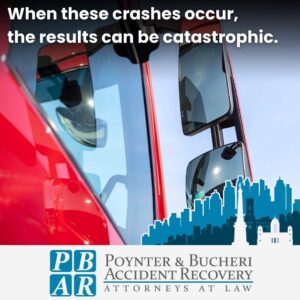
A semi-truck blind spot accident occurs when a commercial truck driver hits a vehicle, pedestrian, or cyclist traveling in an area outside the driver’s view. Because of their length, height, and trailer configuration, semi-trucks have much larger blind spots than passenger vehicles. These “no zones” surround the front, rear, and both sides of the truck.
When these crashes occur, the results can be catastrophic. Victims often suffer serious or fatal injuries, requiring immediate emergency services and extensive medical treatment. The cost of medical bills alone can be overwhelming, and dealing with an insurance company while recovering adds even more stress. That’s why, when you are involved in a large truck accident, understanding your rights and legal options is critical.
Semi-Truck “No Zones”
The massive size of a semi-truck creates multiple blind spots, known as “no zones”, where surrounding vehicles vanish from the driver’s view. Staying in these areas for even a few seconds can lead to devastating accidents and severe injuries.
Understanding where these blind spots are can help motorists avoid dangerous situations, especially when sharing the road with commercial vehicles. If a no-zone crash occurs, working with experienced Indianapolis truck accident attorneys can make a huge difference in protecting your rights and dealing with the insurance company.
Side Blind Spots

The largest blind spot is along the right-hand side of the truck. This zone can extend across several lanes, making it nearly impossible for a driver to see vehicles traveling there. The left side also has a blind spot that stretches from the cab’s door to the rear of the trailer, though it is slightly smaller than the right side. Staying in these areas too long can result in sideswipe collisions that cause life-altering harm.
Rear Blind Spots
A truck’s rear blind spot can extend 30 feet or more behind the trailer. Because truck drivers have no rear-view mirror, they must rely on side mirrors, which do not cover the space directly behind them. Following too closely can put a driver completely out of sight and at risk if the truck slows or stops suddenly. Rear-end collisions in this zone are particularly dangerous due to the force and height of large truck bumpers.
Front Blind Spots
The height of a truck’s cab creates a blind spot extending about 20 feet in front of the vehicle. A car traveling in this space may be completely hidden from the driver’s view. If the truck moves forward unexpectedly or the smaller vehicle stops abruptly, the result can be a serious front-end collision, often leaving victims with significant property damage and long-term injuries.
Common Causes of Blind Spot Semi-Truck Accidents
Even when drivers understand a truck’s no zones, blind spot accidents still occur. When crashes happen involving commercial vehicles, the results can be life-changing, and victims may need an experienced legal team to hold the insurance company accountable. The most frequent causes include:
Drowsy Driving
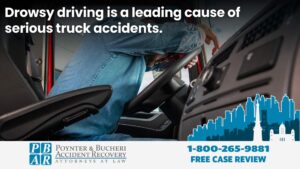
Truck drivers often work long shifts and cover hundreds of miles in a day. Federal regulations limit driving hours, but tight delivery schedules can push drivers to skip rest breaks. Truck driver fatigue slows reaction times, impairs judgment, and makes it more likely for a driver to overlook a vehicle lingering in a blind spot. This form of reckless driving is a leading cause of serious truck accidents.
Distracted Driving
Anything that takes a driver’s attention off the road (such as texting, eating, adjusting the radio, or programming a GPS) can prevent them from noticing a car in a no zone. Because trucks require more time and distance to maneuver, even a momentary distraction can lead to an unsafe lane change or turn, putting passenger cars and motorcycles at serious risk.
Weather
Rain, snow, fog, and even intense sun glare can make blind spots more dangerous. Poor weather reduces visibility, obscures mirrors, and creates slick roads that make sudden stops or swerves riskier. When combined with large blind spots, bad weather greatly increases the chance of a collision involving large trucks.
Size of the Truck
The size of a semi-truck means its blind spots are unavoidable. Long trailers, wide turning radii, and high cabs create zones where smaller vehicles, motorcycles, and pedestrians can vanish from the driver’s sight. When a passenger car driver is caught in these areas, a commercial truck accident can quickly turn into a fatal crash. This is why extra caution is essential when sharing the road with large trucks.
Broken Bone Injuries in a Blind Spot Truck Accident
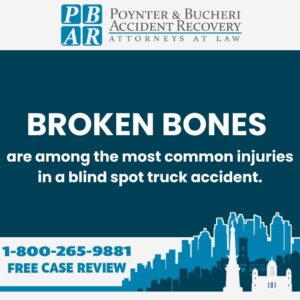
Even a low-speed blind spot collision with a semi-truck can cause serious bodily harm. Broken bones are among the most common injuries, often leaving truck accident victims with significant physical pain, limited mobility, and months of recovery. In severe cases, fractures may lead to permanent impairment or require multiple surgeries to restore function. These crashes can also cause soft tissue injuries that make daily life even more challenging.
Many victims require immediate emergency services at the scene, followed by ongoing treatment and rehabilitation. An experienced legal team can help accident victims recover compensation for their losses through an Indianapolis truck accident claim.
At Poynter & Bucheri, our Indianapolis truck accident attorneys offer a free consultation to explain your rights and pursue the compensation you need to move forward.
Simple or Compound Fracture
A simple fracture is a clean break where the bone remains under the skin, while a compound fracture occurs when the bone pierces through the skin. Compound fractures carry a high risk of infection, nerve damage, and long-term complications, making immediate surgical care necessary. These types of injuries can lead to extended recovery periods and substantial medical bills.
Comminuted Fracture
A comminuted fracture occurs when the bone shatters into three or more pieces, often from the extreme force of a truck collision. These injuries can be complex to treat and may require metal plates, rods, or screws to stabilize the bone during healing. Recovery can take months, and in some cases, mobility is never fully restored, making them some of the most serious injuries after a truck accident.
Hairline Fracture
A hairline fracture is a thin crack in the bone, usually caused by stress or sudden impact. While less dramatic than other fractures, they can still limit movement, cause chronic discomfort, and worsen if not properly diagnosed and treated.
Greenstick Fracture
A greenstick fracture happens when the bone bends and cracks without breaking completely. This type of fracture is most common in children, whose bones are softer and more flexible, but it can occur in adults under certain high-impact conditions.
How the Driver and Truck Company May Share Liability
In many commercial truck accidents, both the truck driver and the trucking company may be held legally responsible for the crash. Determining liability often requires a detailed investigation into the driver’s actions, the company’s policies, and whether either party violated federal or Indiana state trucking regulations.
This process may involve accident reconstruction experts who can analyze evidence, review black box data, and provide insight into the cause of the collision. An Indianapolis truck accident lawyer can coordinate this work as part of building a strong truck accident case.
Truck Driver Liability
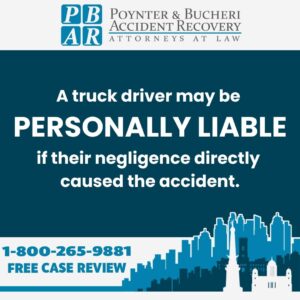
A truck driver may be personally liable if their negligence directly caused the accident. This can include:
- Mirror and blind spot neglect: Failing to check mirrors or blind spots before changing lanes or turning
- Excessive speed: Driving too fast for posted limits, road conditions, or weather
- Impaired or fatigued driving: Operating a vehicle while drowsy, distracted, or under the influence
- Signal failure: Not using proper turn signals when maneuvering
If the driver’s unsafe actions caused the collision, they may be named as a defendant in a personal injury lawsuit. In these situations, having a skilled blind spot truck accidents lawyer in Indianapolis is essential to protect your rights, deal with the insurance company, and pursue the compensation you deserve.
Trucking Company Liability
Trucking companies have a legal duty to ensure their drivers are properly trained, their vehicles are well-maintained, and operations follow safety regulations. A company may share liability if it:
- Unqualified hiring: Employing drivers without proper licensing, training, or experience
- Unrealistic schedules: Pressuring drivers to meet deadlines that encourage speeding or skipping rest breaks
- Poor vehicle maintenance: Failing to repair or service trucks, leading to unsafe operating conditions
- Inadequate training: Not providing sufficient instruction on blind spot awareness and safe lane changes
Many times, an Indianapolis truck accident claim will include allegations against both the driver and the trucking company. Vicarious liability (also called “respondeat superior”) means an employer can be held responsible for the negligent actions of its employee if those actions occurred during the course of their job.
The trucking company’s insurer will often be involved in settlement negotiations, and the legal process may also examine blind spot truck accidents lawyer in Indianapolis ensures every angle is covered.
Loss of Enjoyment of Life Damages After a Blind Spot Accident
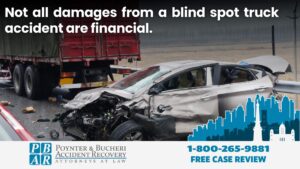
Not all damages from a blind spot truck accident are financial. Some injuries permanently change the way a person lives, preventing them from enjoying hobbies, social activities, or everyday pleasures. This is known as loss of enjoyment of life, a type of non-economic damage that can be included in a truck accident case. With a skilled blind spot truck accidents lawyer in Indianapolis from a trusted law firm, truck accident victims can seek compensation for the ways their injuries have impacted their quality of life.
Loss of enjoyment of life may be claimed when injuries cause:
- Recreational limitations: Reduced ability to participate in sports, travel, or outdoor hobbies
- Social impact: Interference with spending quality time with a family member or close friends
- Loss of independence: Difficulty performing tasks that once brought personal satisfaction
- Ongoing suffering: Persistent pain, discomfort, or mental health struggles that lower overall well-being
In blind spot accidents involving serious injuries, such as traumatic brain injuries, spinal damage, or severe fractures, loss of enjoyment of life damages can be significant. These cases are deeply personal, and proving them often requires compelling testimony and thorough documentation.
Evidence Used to Prove Loss of Enjoyment of Life
To support a claim for loss of enjoyment damages, your truck accident attorney may gather:
- Medical records: Document the extent and permanence of the injury
- Witness testimony: Statements from friends, coworkers, or a family member about lifestyle changes after the accident
- Expert opinions: Insights from medical specialists, vocational experts, or mental health professionals
- Personal journals or statements: Describe the pain, frustration, and limitations caused by the injury.
- Before-and-after comparisons: Photos, videos, or records showing changes in activity levels, such as sports or hobbies
The more detailed and consistent the evidence, the stronger the case for fair compensation. An Indianapolis truck accident attorney can present this proof in a way that resonates with insurance adjusters and juries, helping accident victims recover what they deserve.
Blind Spot Monitors
Modern vehicle safety technology has given drivers more tools than ever to help prevent accidents. One of the most valuable is the blind spot monitor, a system that uses sensors to detect hazards in areas outside the driver’s view.
For passenger vehicles, this technology can be a lifesaver when sharing the road with tractor trailers and other large commercial trucks. For truck drivers, it can mean the difference between a safe lane change and a devastating no-zone collision that causes large truck accident injuries.
Because semi-trucks have significantly larger blind spots than smaller vehicles, even the most attentive drivers may not detect a car, motorcycle, or cyclist in these zones. Blind spot monitoring systems provide real-time alerts, giving drivers more time to react and avoid a crash.
How They Work To Reduce Blind Spot Accidents
Blind spot monitoring systems use sensors to detect when another car, motorcycle, or object is in an area the driver cannot see. When a hazard is detected, the system alerts the driver with visual indicators, such as lights on the side mirrors, audible warnings, or even steering wheel or seat vibrations.
If a crash occurs despite these safety measures, having an Indianapolis truck accident lawyer review your truck accident case can be crucial, as it may involve questions about technology use and driver responsibility.
Some advanced systems add active safety features like steering assistance, automatic braking, or lane-keeping support to help prevent drifting into another lane or colliding with a hidden vehicle.
For truck drivers, blind spot detection systems can provide:
- Real-time alerts: Warn drivers before lane changes, merges, or turns
- Hazard detection: Spot smaller vehicles, motorcycles, or bicycles that may be invisible in mirrors.
- Visibility assistance: Compensate for poor visibility caused by rain, snow, fog, or nighttime driving
- Collision prevention: Reduce the risk of sideswipe crashes from lane shifts or merging errors
While blind spot monitors are a powerful safety tool, they are not a substitute for safe driving practices. Drivers should continue to physically check mirrors, glance over their shoulders when possible, and follow defensive driving habits. Blind spot monitors should be seen as an additional layer of protection, not a replacement for attentive driving.
By combining technology with safe driving habits, both truckers and passenger vehicle drivers can reduce the chances of a tragic no-zone accident. For those injured in such crashes, a skilled blind spot truck accidents lawyer in Indianapolis can help pursue the compensation needed to recover and hold the responsible parties accountable.
How To Avoid a Semi-Truck Blind Spot Accident
While truck drivers must operate their vehicles with care, passenger vehicle drivers also play a critical role in preventing blind spot accidents.
Keep these safety tips in mind when sharing the road:
Stay Out of Blind Spots

If you can’t see the truck driver’s face in their side mirror, likely, they can’t see you. Avoid lingering alongside the trailer, especially on the right-hand side, which has the biggest blind spot. Pass quickly and safely, and don’t cut back into the lane until you can see the entire front of the truck in your rear-view mirror. This is one of the simplest ways to avoid dangerous situations with tractor trailers.
Maintain a Safe Following Distance
Semi-trucks need significantly more time and distance to slow down than passenger vehicles. Leave at least four seconds of space when driving behind a truck. This not only keeps you out of the rear blind spot but also gives you more reaction time if the truck brakes suddenly, helping prevent rear-end crashes that often occur in congested traffic.
Signal Early
When you need to merge or pass near a semi-truck, use your turn signal well in advance. This gives the truck driver time to check their mirrors, clear their blind spots, and adjust their speed or position. Sudden lane changes near a truck greatly increase the risk of a sideswipe accident.
Give Extra Space for Wide Turns
Trucks often need to swing wide—sometimes into adjacent lanes—to make right turns. If you see a truck preparing to turn, do not try to pass on the right or squeeze between the truck and the curb. Give the driver plenty of room to complete the turn safely, especially in crowded intersections with multiple vehicles.
Be Predictable
Large trucks are harder to maneuver and require more time to respond to traffic changes. Avoid sudden lane shifts, abrupt braking, or weaving in and out of traffic. Making steady, predictable movements allows the truck driver to anticipate the actions of other vehicles and adjust accordingly, lowering the risk of an accident occurring.
By keeping these safety tips in mind, drivers can help minimize blind spot risks and share the road more safely with commercial trucks. In the event of a collision, an Indianapolis truck accident case may be necessary to recover compensation for damages.
Poynter & Bucheri: Representing Blind Spot Truck Accident Victims
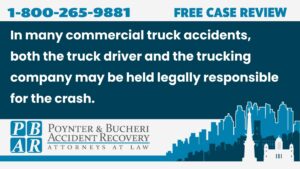
When a blind spot truck accident happens, especially in cases involving commercial vehicles, the consequences are overwhelming. The physical, emotional, and financial toll can feel impossible to manage on your own. That’s why having skilled legal representation is critical in these complex commercial truck accident cases.
At Poynter & Bucheri, our experienced blind spot truck accidents lawyer in Indianapolis knows how to investigate no-zone collisions, work with accident reconstruction experts, and negotiate aggressively with insurance companies. We fight for maximum compensation, whether through settlement or in court.
Your next step is straightforward and risk-free. Call Poynter & Bucheri at 800-265-9881 or schedule a free case evaluation. We’ll review your claim, explain your rights, and develop a strategy to help you recover physically, financially, and emotionally.
